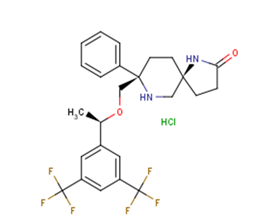
Rolapitant hydrochloride
CAS No. 914462-92-3
Rolapitant hydrochloride( —— )
Catalog No. M17656 CAS No. 914462-92-3
Rolapitant Hydrochloride is the hydrochloride salt form of rolapitant, an orally bioavailable, centrally-acting, selective, neurokinin 1 receptor (NK1-receptor) antagonist with potential antiemetic activity.
Purity : >98% (HPLC)
 COA
COA
 Datasheet
Datasheet
 HNMR
HNMR
 HPLC
HPLC
 MSDS
MSDS
 Handing Instructions
Handing Instructions
| Size | Price / USD | Stock | Quantity |
| 5MG | 1503 | In Stock |


|
| 50MG | 3042 | In Stock |


|
| 100MG | 4140 | In Stock |


|
| 200MG | Get Quote | In Stock |


|
| 500MG | Get Quote | In Stock |


|
| 1G | Get Quote | In Stock |


|
Biological Information
-
Product NameRolapitant hydrochloride
-
NoteResearch use only, not for human use.
-
Brief DescriptionRolapitant Hydrochloride is the hydrochloride salt form of rolapitant, an orally bioavailable, centrally-acting, selective, neurokinin 1 receptor (NK1-receptor) antagonist with potential antiemetic activity.
-
DescriptionRolapitant Hydrochloride is the hydrochloride salt form of rolapitant, an orally bioavailable, centrally-acting, selective, neurokinin 1 receptor (NK1-receptor) antagonist with potential antiemetic activity.(In Vitro):Rolapitant has high selectivity over the human NK2 and NK3 subtypes of more than 1000-fold, as well as preferential affinity for human, guinea pig, gerbil and monkey NK1 receptors over rat, mouse and rabbit.Rolapitant (1-1000 nM) inhibits the GR-73632 (an NK1 receptor agonist)-induced calcium efflux with a concentration-dependent and competitive manner in CHO cells expressing the human NK1 receptor.(In Vivo):Rolapitant (0.03-1 mg/kg for PO, 0.3-1 mg/kg for IV; single dosage) attenuates the GR-73632-induced foot-tapping response in Mongolian Gerbils.Rolapitant (0.03-1 mg/kg; PO; single dosage; observed for 72 h) blocks acute emesis induced by both apomorphine and cisplatin in ferrets.
-
In Vitro——
-
In VivoAnimal Model:Female Mongolian Gerbils (30-60 g; anesthetized by inhalation of an oxygen:isofluorane mixture after 4 h PO or immediately after IV, then injected with 5 μl of 3 pmol solution of GR-73632 via ICV)Dosage:0.03, 0.1, 0.3 and 1 mg/kg for PO, 0.3 and 1 mg/kg for IVAdministration:PO or IV, single dosageResult:Attenuated dose-dependently the GR-73632-induced foot-tapping response when administered PO 4 h before testing, with an ID90 of 0.3 mg/kg, and the inhibition in foot tapping for at least 24 h.Blocked dose-dependently the foot tapping induced by GR-73632 when administered IV, with complete blockade observed at 1 mg/kg.Animal Model:Ferrets (treated with subcutaneous administration of 0.125 mg/kg apomorphine or intraperitoneal administration of 10 mg/kg cisplatin)Dosage:0.03, 0.1, 0.3 and 1 mg/kg Administration:PO; single dosage; observed for 72 h Result:Blocked dose-dependently acute emesis induced by both apomorphine and cisplatin in ferrets.Produced a robust decrease in retches and vomits in ferrets that was maintained throughout the 72 h observation period.
-
Synonyms——
-
PathwayEndocrinology/Hormones
-
TargetAndrogen Receptor (AR)
-
RecptorNK1
-
Research AreaOthers-Field
-
Indication——
Chemical Information
-
CAS Number914462-92-3
-
Formula Weight536.94
-
Molecular FormulaC25H27ClF6N2O2
-
Purity>98% (HPLC)
-
SolubilityIn Vitro:?DMSO : 250 mg/mL (450.49 mM)
-
SMILESC[C@H](c1cc(cc(c1)C(F)(F)F)C(F)(F)F)OC[C@]1(CC[C@]2(CCC(=O)N2)CN1)c1ccccc1.Cl
-
Chemical Name——
Shipping & Storage Information
-
Storage(-20℃)
-
ShippingWith Ice Pack
-
Stability≥ 2 years
Reference
1.Rapoport B, Schwartzberg L, Chasen M, Powers D, Arora S, Navari R, Schnadig I. Eur J Cancer. 2016 Apr;57:23-30.
molnova catalog



related products
-
GSK-2881078
A potent and selective androgen receptor modulator (SARM) for the treatment of cachexia.
-
LGD-3303
LGD-3303 is an orally available, brain-penetrant nonsteroidal selective androgen receptor modulator (SARM) that that shows little or no cross-reactivity with related nuclear receptors.
-
Enzalutamide carboxy...
Enzalutamide carboxylic acid is an antagonist of androgen receptor (AR) .



 Cart
Cart
 sales@molnova.com
sales@molnova.com


